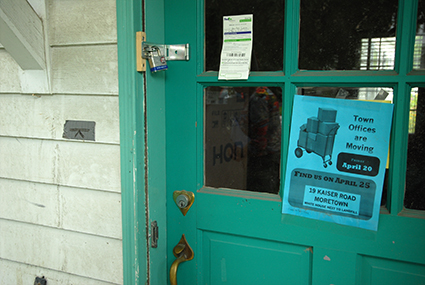Earlier this month, well over 100 people packed into the gym at Waitsfield Elementary School to share their opinions about where the new town offices should be located. A couple of miles down the road and a couple of steps behind in the site selection process, the most recent Moretown Town Office Committee meeting was a far quieter affair, but the committee is calling for feedback at a public forum scheduled for Thursday, January 10, at 7 p.m. at the Moretown Town Hall.
The Moretown town offices were destroyed due to flooding from Tropical Storm Irene in August 2011. Last December, the town formed a committee to recommend sites on which to rebuild and—after conducting an all-inclusive search—the committee published a price comparison chart for potential town office sites last month.
In the meantime, the town established a temporary office at Kaiser Drive on Route 2, in a building directly adjacent to Moretown Landfill. Renovating the Kaiser Drive building for permanent use ($756,875) is one of the options included in the price comparison chart.
The other sites currently under consideration are a space adjacent to the Moretown Elementary School playground ($790,950), a space adjacent to the school’s tennis courts ($912,211), a space off of Fox Farm Run called the “Kingsbury Site” ($844,144), space in the front half of Moretown Elementary School ($1,625,625) and the existing town office ($813,159).
At first the committee agreed that—at nearly twice the price of the other sites—the space in the front half of Moretown Elementary School was “a non-starter.” At its most recent meeting, which took place on Thursday, December 13, however, the committee began to rethink its dismissal of the site.
The preliminary price estimate for the space in Moretown Elementary School included the cost of renovating two classrooms that the school could use if needed. If those renovations were left out, the site would cost about $700,000 less, bringing it back in line with the other price estimates.
While committee member John Schmeltzer feels that the space in Moretown Elementary School could make a good site for the new town offices, “the space is also an asset to the school,” he said, “and they’d pretty much lose that for forever.”
“The attraction [of using the school] is significant for me,” committee chair Clark Amadon said, but he clarified that the committee would need to hear from the school board before pursuing the option.
“Really, I think what’s important is that everybody is comfortable where [the new town offices] are located,” Schmeltzer said, referring to the distance and consequential sense of disconnect between the Kaiser Drive building and the other sites under consideration, which are all located in the center of town.
Perhaps the Kaiser Drive building’s biggest downside—its remote Route 2 location—is also its biggest upside, however, because unlike the sites located along the Mad River in Moretown Village, the Kaiser Drive building is far from the floodplain.
“We need to build something that we know we can count on in an emergency,” Schmeltzer said, and there’s no guarantee that any of the proposed Moretown Village sites could not flood again.
As a precaution, any town office constructed in the village would have to be elevated in order to qualify for Federal Emergency Management Agency (FEMA) funding. This includes the existing town office building, which the town would need to raise eight feet—one foot above the 500-year flood level—and committee members worry that the result could be rather unsightly.
And, as the town strives to meet FEMA’s requirements, the amount of money that Moretown will receive from the Federal Emergency Management Agency remains uncertain. “The thing about FEMA is, we just don’t know,” Amadon said.
So far, the committee has submitted a scope change request to FEMA, which is necessary if the town wants to rebuild in a new location rather than on the old site. Next, the committee will work next on providing documentation that the new town offices are indeed a “critical facility,” which will affect the amount of aid that the town will receive.
At the upcoming public forum, the committee will provide an update on its dealings with FEMA and insurance companies, as well as give an overview of its site selection process before asking for feedback on finalists.
“We started out with a list of sites that were very long, and some of them were very improbable,” committee member Jonathan Siegel said, “but we’ve pared it down to half a dozen sites that are realistic.”
While cost is certainly a huge factor in selecting a site, “we need to make sure we’re thinking about the people who are going to be in this building 20 years from now,” Amadon said, and he hopes to see residents make an informed decision on which site will be not only best for the budget but best for the town, in the long run.
{loadnavigation}







